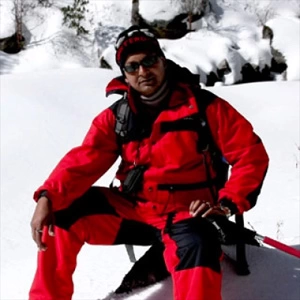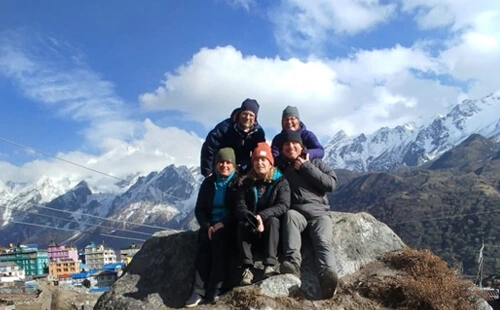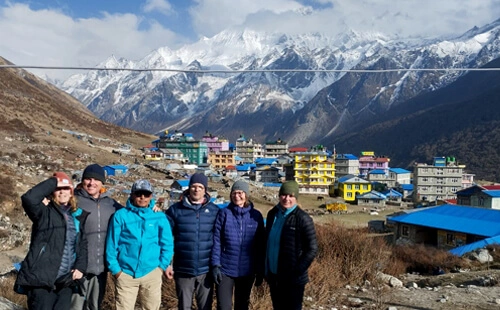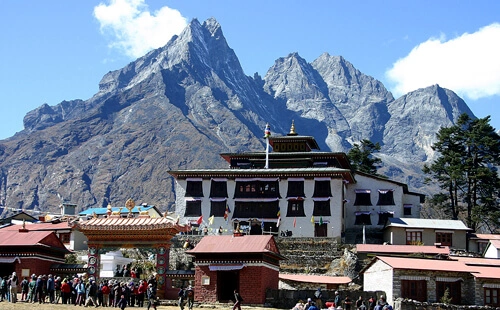How far is the Everest Trekking from Kathmandu?
The Everest Trekking region is located in the northeastern part of the Nepalese Himalayas, which although accessible by both roadways and airways, the overland tip such as Jiri to Everest Base Camp can take several days of walking through a comparatively arduous environment; hence, a flight to Lukla and trekking onward is the best way to explore the Everest/Lhumbu region, which covers approximately 138 km/86 miles from Kathmandu in 30 to 40 minutes from the capital city of the country, Kathmandu.
While from Lukla, the Everest Base Camp odyssey can span about 65 km/40 miles one way and greater or less than that based on certain itineraries and trekking routes you have picked for yourself that may take anywhere from 14 to 18 days, including much-needed buffer days to mitigate the chances of acute mountain sickness (AMS) or altitude sickness.
What are the major highlights of the Everest Trekking?
The Everest Trekking region is widely popular for various reasons, be it the epic Himalayan scenery right from the thrilling flight to and from Lukla, the bustling Sherpa town, the tranquil ambiance of Tenboche monastery, and several others, as discussed below in this blog of Mount Everest trekking information:
Lukla Airport: Also noted as one of the airports at the highest altitudes, the Lukla Airport, at an altitude of 2,860 m (9,383 ft) above sea level in the Solukhumbu District of the Khumbu region, is one of the key features of trekking to Everest and has been serving as a gateway to several trekking routes in the realm.
Namche Bazaar: Situated at an elevation of 3,440m/11,286ft, Namche Bazaar is a bustling Sherpa capital that has one of the most stunning looks out at sky towering snow-capped peaks including that of the top of the world, Mt. Everest (8,848m) while you explore and discover several historical, cultural, and natural landmarks.
Tengboche Monastery: Giving access to one of the most spectacular sights of Ama Dablam, Everest, and other peaks is Tengboche Monastery, the largest of its kind in the entire region and functioning as the spiritual center of Everest.
The Sagarmatha National Park: Home to a diverse range of flora and fauna, Sagarmatha National Park is also one of the UNESCO World Heritage Sites of Nepal, where you can even spot elusive snow leopards, Himalayan black bears, and others. It is one of the major high points of Everest Trekking.
Kala Patthar and Gokyo Ri: Both are wonderful viewpoints of the Everest region, with unparalleled panoramic views of Everest, Lhotse, Nuptse, and other surrounding peaks, especially during sunset and sunrise, one at an altitude of 5,545 m/18,162 ft and another at 5,357 m/17,575 ft.
The Everest Base Camp: It is the closest you can get to the largest mountain range on earth without summiting the peak itself, and you can embrace the ultimate serenity and tranquility that the foot stand has to offer with the ultimate scenic views of Khumbu Icefall and glacier. At the same time, you also get to watch climbers get ready for their summit attempts.
Gokyo Lakes and Valleys: Originating directly from nearby mountain glaciers, the Gokyo Lakes are a series of six glacial lakes marked for their spectacular turquoise surroundings in contrast to the completely whitewashed snow-clad mountain peaks in the Everest Himalayas. Nearby lies the picturesque Sherpa settlement, warming you with their genuine hospitality and smiles.
While these are key features of a trek to the Everest region, you can always expect something out of the ordinary on the trekking trials based on the specifics you have chosen to follow, led by your mountain guide or leaders.
Which months are best for trekking to Everest?
Everest Trek throughout the year prevails! However, the months of March to May (spring) and September to November (autumn) are noted for moderate temperatures, generally clear skies, unobstructed views of the snow-capped peaks, and mild walking days, with the excellent condition of hiking trails especially necessary if you are looking forward to conquering the peak itself.
Furthermore, the spring enhances the beauty of the whole Everest Trekking region with full and fresh blooms of rhododendrons and other wildflowers, adding much to the preexisting vibrant landscapes of the region, whereas the autumn usually coincides with numerous festivals and celebrations of the nation, filling the ambiance fully with joy and colors of happiness. By following this comprehensive Everest trek information, on booking your Everest trek in autumn you can get to be part of the grand festivals, ceremonies, and celebrations creating an otherworldly experience for you.
What are the permits for Everest Trekking?
Before officially embarking on the Everest Trek, it is important to obtain the necessary permits that contribute to supporting the conservation efforts in the national park, ensure your safety en route, track, and register your visit so you get essential aid in an emergency, which are:
The Sagarmatha National Park Entry Permit
Like any other trekking region in Nepal, the Everest Trekking region also falls under one of the highly conserved Sagarmatha National Park Areas and hence requires a mandatory permit called the Sagarmatha National Park that gives you legal access to the national park.
Generally, the Nepal Tourism Board (NTB) and Trekking Agencies Association of Nepal (TAAN) issue the Sagarmatha National Park entry that can cost approximately USD 30 (NPR 3,000) without any trek day restriction and is usually covered by the trekking package cost from any leading and trustworthy travel, treks, and tour operators such as Adventure Himalayan Travels and Treks.
Khumbu Pasang Lhamu Rural Municipality Permit
In addition to the Sagarmatha National Park Entry Permit, the local authorities of the Khumbu/Everest region have the mandatory requirement of having to obtain the local permit called the Khumbu Pasang Lhamu Rural Municipality, which is also known as the local government permit instead of the TIMS (Trekkers Information Management Systems) Card.
It was introduced to uplift the lifestyles of the Himalayan locals residing in the area, supporting local development and infrastructure in the remote Khumbu region involving waste management and maintenance of trekking trails, which cost around NPR 2,000 (approximately USD 20) per person and are available through any government-licensed trekking guides and companies.
Can you get vegetarian meals on the way to the Everest Trekking?
Yes, commonly, the tea houses and lodges along the Everest Trekking region of Nepal offer a variety of meal options where you can stick to the vegetarian option, such as Dal Bhat (lentil soup followed by heaps of rice), vegetable fried rice or noodles, veg momos, pasta, soups, varieties of potatoes, chapati with vegetables, porridge, and pancakes.
These vegetarian options cater to trekkers with various dietary preferences or restrictions, where the choice may get limited as you move to higher and higher altitudes in the Everest Himalayas, but overall, they are hearty, filling, and full of nutrients, providing trekkers, travelers, and climbers with enough proteins, carbohydrates, and other minerals essential for the Upper Himalayas odyssey to the Everest Trekking region.
Does the Everest Trek route possess private rooms?
Yes, private rooms are available along the Everest Trekking Route, particularly in the lower altitude areas like Lukla, Phakding, Namche Bazaar, and Tengboche, but their availability and quality can vary significantly depending upon the remoteness, trekking seasons, and altitude of tea houses and local lodges.
However, as you go higher in the Everest region, such as Everest Base Camp, Gokyo Lakes and Valley, Kala Patthar, and Gokyo Ri, the availability of private rooms can get minimal, simply furnished, often with shared bathrooms, rooms with twin beds, and common areas in comparison to lower altitudes, especially during the peak Himalayan trekking seasons (spring and autumn), now that you are on an absolute Everest Trek Guide.
Therefore, if you are seeking more comfort and privacy during the Everest Trek, try booking your rooms in advance, arriving earlier, and keeping yourself flexible enough to adapt to the sare rooms or dormitory-type accommodation.
Where can you find bottled water on the way to Everest Trekking?
Bottled water is available along the Everest Trekking routes, including key stops such as Lukla, Phakding, Namche Bazaar, Tengboche, Dingboche, and many others, which may cost you a bit more than in the city areas such as Kathmandu and Pokhara. However, plastic bottles leave a significant impact on the environment, so they are not recommended.
Rather, as responsible travelers in this Everest trekking guide trekkers are mostly advised to use water purification methods like tablets, filters, or UV purifiers before consuming water directly from the water resources present en route to the Everest Trek, such as waterfalls, ponds, lakes, and streams. While along the tea houses and local lodges, you can always get your thermal water bottled and refilled with lukewarm drinking water that might charge you additionally but is a reliable way to drink healthy as well.
How do you connect to your family and friends during Everest Trekking?
Although many tea houses and lodges en route to the Everest Trekking Odyssey do provide you with WiFi, sometimes complementary, sometimes at some additional cost, the quality and speed of the connection can be unreliable as you ascend. For more stable communication, it is wise to purchase a Nepalese SIM card such as Ncell or NTC and connect to your loved ones whenever you receive a strong signal.
While the mobile network coverage becomes spotty at higher elevations during the Everest Trek, for better communication, in case of medical or any other emergencies or other unforeseen Himalayan circumstances, consider renting a satellite phone. Further, it is recommended to carry a power bank to keep your electronic devices charged, get high-voltage power banks, inform your family and friends about possible communication gaps, and make sure to list your emergency contacts.
Is Everest Trekking difficult to conquer?
Trekking to the Everest region is indeed a challenging endeavor due to the high elevation, varied landscape, unpredictable weather conditions, and several steep ascents and descents in the rugged terrain, but it is not insurmountable for those with proper physical fitness, preparation, a positive mindset, and mental resilience.
For several days you will be walking above 3,300 m in altitude sickness, also known as acute mountain sickness (AMS)-prone areas, for approximately 5-8 hours each day on varied terrain, including steep ascents, descents, rocky moraine, and sometimes icy and snowy sections.
The weather also can change frequently with colder nights where hiring guides and porters can significantly enhance the overall journey to the Everest region. Nonetheless trekking to the Everest region is an iconic expedition regardless of which route you choose to follow and itinerary you wish to craft to discover and explore the serene natural beauty and cultural richness of the Himalayas along the way.
What to do during acute mountain sickness or altitude sickness during the Everest trek?
Acute mountain sickness (AMS) or altitude sickness is a common concern for trekkers, adventurers, climbers, and expeditors in high altitudes like the Everest Himalayas, where it is crucial to recognize symptoms before taking any actions that include headache, nausea, dizziness, fatigue, loss of appetite, unusual difficulty sleeping, swelling of hands, feet, and face in mild symptoms for which you can stop ascending immediately and rest wherever you are at, drink adequate water, consume light food rich in carbohydrate, consider medication for headache, and last but not least avoid alcoholic products.
Similarly, the severe symptoms of AMS include constant headache, vomiting, rapid or heavy breathing even at rest, confusion, lack of coordination, persistent coughing, clumsiness, or drowsiness. To deal with it, you must descend to a lower altitude as quickly and safely as possible, seek medical help immediately if symptoms persist or worsen arrange emergency helicopter evacuation, and use oxygen supplements if available.
How do you keep yourself physically fit for Everest Trekking?
Though there are no age and experience criteria for trekking to the Everest region of Nepal, trekkers hoping for any sort of outdoor adventure must be in commendable physical condition that also boosts confidence, for which you can engage yourself in the following activities to make sure you are fit enough for the upcoming journey:
- Include cardiovascular training in your daily routine, such as running, jogging, cycling, swimming, stair climbing, and others.
- Strength training focuses on the legs, core, and upper body, for which you can do squats, lunges, step-ups, planks, leg raises, Russian twists, push-ups, pull-ups, and shoulder presses.
- Practice hiking with backpacks in varying terrain that resembles the Everest Himalayas.
- For increased flexibility and balance, include yoga and stretching. Focus on major muscle groups used during trekking and hiking, such as the calves, hamstrings, quads, and hip flexors.
- Increase the intensity and duration of your workouts gradually to avoid injuries and accidents.
- Keep yourself hydrated and consume healthily.
- Listen to your body, pay attention to the symptoms of over-exhaustion, and allow profound rest, exercise, etc.
- To sum it up, for better physical conditioning, going to Everest Trekking includes a combination of cardiovascular exercise, strength training, hiking practices, a balanced and healthy diet, and core area training.
What are the essential trekking gear and equipment for trekking to the Everest region?
The right gear for the Everest Trek greatly enhances the overall Himalayan tour experience, ensuring your ultimate safety and comfort. What you exactly need may vary depending on the trekking season, duration of your journey, and personal preferences, so make sure you have what it requires to navigate the challenging terrain and high altitudes.
Here is a general list of essential gear, equipment, and basic necessities to include in your backpack for Everet trekking. It is better if you pack as lightly as possible, carrying only those that are absolute necessities without stuffing, including:
Clothing: moisture-soaking long-sleeve shirts and pants as base layers; a fleece or down jacket; and an insulated pant as an insulating layer for the higher Himalayas. Water- and wind-proof jackets and pants as outer layers; a few pairs of thick and thin socks; pairs of underwear; gloves for colder temperatures; a sun hat or cap for sunny days; and a buff or scarf to protect yourself from cold and dust.
Footwear: Perfectly fitting, lightweight, and sturdy hiking boots and lightest camp shoes or sandals.
Trekking accessories: Backpack with at least 50-60l capacity, adjustable, stable, and quality trekking poles, sunglasses, sun creams, and headlamps.
Hydration and nutrition: Reusable water bottles, water purification systems, energy bars, nuts, dried fruits, and other snacks.
Health and safety: The first aid kit includes basic antiseptic, blister treatment, and personal medications; sunscreen with high SPF and strong UV ray protection; lip balm with SPF; wet wipes; hand sanitizer; toilet paper; and biodegradable soap.
Sleeping gear: sleeping bag and bag liner for extra warmth and hygiene.
Miscellaneous: maps and guidebooks; cameras and smartphones to capture memories; a high-voltage power bank; trekking permits; Nepali cash; and travel insurance.
Optional items: gaiters for snowy weather and trekking trails; earplugs or earphones for noise management; books, pens, journals, etc.
Must you get travel insurance to go trekking to Everest?
Although travel insurance for Everest Trekking is not a legal requirement, it is absolutely necessary for trekking in an area of high altitude in the remote and comparatively demanding nature of hiking routes where even small injuries or sprains might lead to serious consequences. Therefore, getting yourself sufficient travel insurance is a must for Himalayan Odyessy to Everest that safeguards your health, safety, and financial investment by:
- This gives you access to emergency helicopter evacuation, which can be extremely expensive at high altitudes in the remote Himalayas, where the risk of altitude sickness and medical emergencies can be a normal occurrence.
- Providing coverage for medical expenses in case of serious illness, injury, or any other unpredictable events where you might even have to be transported to Kathmandu or other cities for more advanced treatment.
- Reimbursing you for non-renewable expenses incurred by having to cancel the trip or cut short your trip.
- Covering up the loss or theft of goods and personal belongings en route to the Everest trek.
- Helping you cover additional accommodation, transportation, and meal costs incurred due to delays of flights or cancellations, etc.
Now, finding the right policy covering all events and environments related to Everest Trekking can be one heck of a hectic experience therefore when selecting travel insurance make sure it includes the given:
- Particularly covers high-altitude trekking, typically up to 6,000 m.
- Comprehensive coverage for helicopter evacuation from remote landscapes includes medical treatment, hospitalization, medication, and treatment costs both locally and in city areas.
- Reimbursement for non-refundable expenses for trip cancellations and interruptions due to unavoidable circumstances such as natural disasters.
- Coverage for lost, stolen, or damaged goods, gear, equipment, and personal items during the Everest Trek days.
- Personal liability coverage in case you accidentally cause injury or property damage to someone else.
Why is it necessary to hire guides and porters for the Himalayan Odyssey to Everest?
While the whole nation has banned solo trekking since April 1st, 2023, the Everest Trekking region still might allow trekkers to traverse the region with the assistance of at least one professional government-licensed guide, where they come together with porters to ensure your safety, cultural insight, support for the local economy and environment, managing logistics, and others, as explained below:
- The extreme knowledge of guides about the local trekking trails, weather conditions, and potential hazards aids greatly in navigating the terrain safely while ensuring you stay on the correct path and avoid dangerous areas.
- Local Sherpa guides provide an insider insight into the local culture, traditions, and history of the region, broadening the chances of seamless cultural exchange while you make your way through several historical and local landmarks and establish respectful interaction with local communities.
- Usually, guides are fluent English speakers who may even possess multilingual language knowledge, including local dialects, which helps you bridge communication gaps and upgrade your interactions with locals residing on the way.
- Porters carry your heavy backpack, gear, and supplies so you can conserve energy for the challenging terrain and high altitudes while enjoying yourself to the fullest during the Everest Trek.
- Guides can be helpful in arranging the best accommodations and meals, even during peak trekking seasons, along with securing essential permits and handling other logistics.
- Guides are most likely to tailor the Everest hiking experience as per your needs, preferences, pace, schedule, and many others.
Budgets and Cost for Everest Trekking
Traditionally, the Everest Trek can cost around USD 2,000 to USD 2,500 or more based on the duration of your journey, the trek starting and ending points, the season of your trek to the Everest Himalayas, the level of services excluded and included, and the type of trek, travel, and tour operator you have selected for the trip, and so on.
Although a solo trip to the Everest region might be a cost-effective method, you would not want to deal with the chaotic processes of having to obtain permits and manage all sorts of trekking logistics by yourself in relatively new terrain and environments in the remote Nepalese Himalayas.
Therefore, getting one of the trekking packages of your liking from the trekking and traveling company of your trust is the best way to go for Everest Trekking, where several tour and trek organizers such as Adventure Himalayan Travels and Treks provide services, itinerary, and budget plans that match the international operators relatively at lower prices with no compromise in quality.
The above-mentioned are the top 15 must-know things for Everest Trekking for a complete guide before you begin your journey as a beginner. For the validity and reliability of the information, please stay in contact so you get the latest update on these subjects of change.




